- Home
- Elizabeth Gilbert
Committed Page 18
Committed Read online
Page 18
So that’s one way to do it.
To be perfectly honest, though, this kind of brave and willful act of self-selection was never modeled for me within my own family’s history. I never saw anything like Christine’s boat as I was growing up. I never saw any woman actively marrying her own life. The women who have been most influential to me (mother, grandmothers, aunties) have all been married women in the most traditional sense, and all of them, I would have to submit, gave up a good deal of themselves in that exchange. I don’t need to be told by any sociologist about something called the Marriage Benefit Imbalance; I have witnessed it firsthand since childhood.
Moreover, I don’t have to look very far to explain why that imbalance exists. In my family, at least, the great lack of parity between husbands and wives has always been spawned by the disproportionate degree of self-sacrifice that women are willing to make on behalf of those they love. As the psychologist Carol Gilligan has written, “Women’s sense of integrity seems to be entwined with an ethic of care, so that to see themselves as women is to see themselves in a relationship of connection.” This fierce instinct for entwinement has often caused the women in my family to make choices that are bad for them—to repeatedly give up their own health or their own time or their own best interests on behalf of what they perceive as the greater good—perhaps in order to consistently reinforce an imperative sense of specialness, of chosenness, of connection.
I suspect this may be the case in many other families, too. Please be assured that I know there are exceptions and anomalies. I myself have personally witnessed households where the husbands give up more than the wives, or do more child rearing and housekeeping than the wives, or take over more of the traditional feminine nurturing roles than the wives—but I can count those households on exactly one hand. (A hand that I now raise, by the way, to salute those men with enormous admiration and respect.) But the statistics of the last United States Census tell the real story: In 2000, there were about 5.3 million stay-at-home mothers in America, and only about 140,000 stay-at-home dads. That translates into a stay-at-home-dad rate of only about 2.6 percent of all stay-at-home parents. As of this writing, that survey is already a decade old, so let’s hope the ratio is changing. But it can’t change fast enough for my tastes. And such a rare creature—the father who mothers—has never been a character anywhere in the history of my family.
I do not entirely understand why the women to whom I am related give over so much of themselves to the care of others, or why I’ve inherited such a big dose of that impulse myself—the impulse to always mend and tend, to weave elaborate nets of care for others, even sometimes to my own detriment. Is such behavior learned? Inherited? Expected? Biologically predetermined? Conventional wisdom gives us only two explanations for this female tendency toward self-sacrifice, and neither satisfies me. We are either told that women are genetically hardwired to be caretakers, or we are told that women have been duped by an unjustly patriarchal world into believing that they’re genetically hardwired to be caretakers. These two opposing views mean that we are always either glorifying or pathologizing women’s selflessness. Women who give up everything for others are seen as either paragons or suckers, saints or fools. I’m not crazy about either explanation, because I don’t see the faces of my female relatives in any of those descriptions. I refuse to accept that the story of women isn’t more nuanced than that.
Consider, for instance, my mother. And believe me—I have been considering my mother, every single day since I found out I would be marrying again, since I do believe that one should at least try to understand one’s mother’s marriage before embarking on a marriage of one’s own. Psychologists suggest that we must reach back at least three generations to look for clues whenever we begin untangling the emotional legacy of any one family’s history. It’s almost as though we have to look at the story in 3-D, with each dimension representing one unfolding generation.
While my grandmother had been a typical Depression-era farmwife, my mother belonged to that generation of women I call “feminist cuspers.” Mom was just a tiny bit too old to have been part of the women’s liberation movement of the 1970s. She had been raised to believe that a lady should be married and have children for exactly the same reason that a lady’s handbag and shoes should always match: because this was what was done. Mom came of age in the 1950s, after all, during an era when a popular family advice doctor named Paul Landes preached that every single adult in America should be married, “except for the sick, the badly crippled, the deformed, the emotionally warped and the mentally defective.”
Trying to put myself back into that time, trying to understand more clearly the expectations of marriage that my mother had been raised with, I ordered online an old matrimonial propaganda film from the year 1950 called Marriage for Moderns. The film was produced by McGraw-Hill, and it was based on the scholarship and research of one Professor Henry A. Bowman, Ph.D., chairman of the Division of Home and Family, Department of Marriage Education, Stephens College, Missouri. When I stumbled on this old relic, I thought, “Lordy, here we go,” and I set myself up to be fully entertained by a bunch of tacky, campy, postwar drivel about the sanctity of the home and hearth—starring coiffed actors in pearls and neckties, basking in the glow of their perfect, model children.
But the movie surprised me. The story begins with an ordinary-looking young couple, modestly dressed, sitting on a city park bench, talking to each other in quiet seriousness. Over the image, an authoritative male narrator speaks about how difficult and terrifying it can be “in the America of today” for a young couple even to consider marriage, given how rough life has become. Our cities are haunted by “a social blight called slums,” the narrator explains, and we all live in “an age of impermanence, an age of unrest and confusion, under the constant threat of war.” The economy is troubled, and “rising living costs vie against flagging earning power.” (Here, we see a young man walking dejectedly past a sign on an office building reading NO JOBS AVAILABLE, DO NOT APPLY.) Meanwhile, “for every four marriages, one ends in divorce.” It’s no wonder, then, that it’s so difficult for couples to commit to matrimony. “It is not cowardice that gives people pause,” the narrator explains, “but stark reality.”
I could not quite believe what I was hearing. “Stark reality” was not what I had expected to find here. Hadn’t that decade been our Golden Age—our sweet national matrimonial Eden, back when family, work, and marriage were all sanctified, straightforward ideals? But as this film suggested, for some couples, at least, questions about marriage were no simpler in 1950 than they have ever been.
The film specifically highlights the story of Phyllis and Chad, a recently married young couple trying to make ends meet. When we first meet Phyllis, she’s standing in her kitchen, washing dishes. But the voice-over tells us that only a few years earlier, this same young woman “was staining slides in the pathology lab at the university, making her own living, living her own life.” Phyllis had been a career girl, we are told, with an advanced degree, and she had loved her work. (“Being a bachelor girl wasn’t the social disgrace it was when our parents called them spinsters.”) As the camera catches Phyllis shopping for groceries, the narrator explains, “Phyllis didn’t marry because she had to. She could take it or leave it. Moderns like Phyllis think of marriage as a voluntary state. Freedom of choice—it’s a modern privilege and a modern responsibility.” Phyllis, we are told, volunteered for marriage only because she decided that she wanted a family and children more than she wanted a career. That was her decision to make, and she stands by it even though her sacrifice has been a significant one.
Soon enough, though, we see signs of strain.
Phyllis and Chad had apparently met in math class at the university, where “she had gotten better grades. But now he’s an engineer and she’s a housewife.” Phyllis is shown dutifully ironing her husband’s shirts at home one afternoon. But then our heroine finds herself distracted when she stumbles on the plans
her husband has been drawing up for a big building competition. She takes out her slide rule and starts checking up on his figures, just as she knows he would want her to. (“They both know she’s better at math than he is.”) She loses track of time, becoming so engaged in her calculations that she leaves the ironing unfinished; then she suddenly remembers that she’s late for her appointment at the health clinic, where she’s going to discuss her (first) pregnancy. She had entirely forgotten about the baby inside her because she was so captivated by her mathematical calculations.
Sweet heavens, I thought, what kind of 1950s housewife is this?
“A typical one,” the narrator tells me, as though he had heard my question. “A modern one.”
Our story continues. Later that night, pregnant Phyllis the math wiz and her cute husband Chad sit in their tiny apartment, smoking cigarettes together. (Ah, the fresh nicotine taste of 1950s pregnancies!) Together, they are working on Chad’s engineering plans for the new building. The phone rings. It’s a friend of Chad’s; he wants to go to the movies. Chad looks to Phyllis for approval. But Phyllis argues against it. The competition deadline is coming up next week and the plans need to be completed. The two have been working so hard on this! But Chad really wants to see the movie. Phyllis holds her ground; their whole future rests on this work! Chad looks disappointed, almost childishly so. But he relents in the end, sulking a bit, and allows Phyllis to literally push him back to the drawing table.
Our omniscient narrator, analyzing this scene, approves. Phyllis is not a nag, he explains. She has every right to demand that Chad stay home and complete a business project that could advance them both mightily in the world.
“She gave up her career for him,” says our sonorous male narrator, “and she wants to see something come of it.”
I felt a strange combination of embarrassment and emotion as I watched this film. I was embarrassed that I’d never before imagined American couples of the 1950s having conversations like this. Why had I unquestioningly swallowed the conventional cultural nostalgia, that this era had somehow been a “simpler time”? What time has ever been a simple time for those who are living it? Also, I was touched that the filmmakers were defending Phyllis in their own small way, trying to get across this vital message to the young grooms of America: “Your beautiful, intelligent bride just gave up everything for you, buster—so you’d damn well better honor her sacrifice by working hard and giving her a life of prosperity and security.”
Moreover, I found myself moved that this unexpectedly sympathetic response to a woman’s sacrifice had come from somebody as clearly male and authoritative as Dr. Henry A. Bowman, Ph.D., Chairman of the Division of Home and Family, Department of Marriage Education, Stephens College, Missouri.
That said, I couldn’t help wondering what would happen to Phyllis and Chad about twenty years down the road—when the children were older and the prosperity had been achieved, and Phyllis had no life whatsoever outside of the home, and Chad was starting to wonder why he’d given up so much personal pleasure over the years to be a good and faithful provider, only to be rewarded now with a frustrated wife, rebellious teenage children, a sagging body, and a tedious career. For wouldn’t those be the very questions that would explode across American families in the late 1970s, running so many marriages off the rails? Could Dr. Bowman—or anybody else back in 1950, for that matter—ever have anticipated the cultural storm that was coming?
Oh, good luck, Chad and Phyllis!
Good luck, everyone!
Good luck, my mother and father!
Because, while my mom may have defined herself as a 1950s bride (despite having married in 1966, her assumptions about marriage hearkened back to Mamie Eisenhower), history dictated that she grow into a 1970s wife. She had been married only five years, and her daughters were barely out of diapers, when the big wave of feminist turbulence really hit America and shook every assumption about marriage and sacrifice she’d ever been taught.
Mind you, feminism did not arrive overnight, as it sometimes seems. It’s not as though women across the Western world just woke up one morning during the Nixon administration, decided they’d had enough, and took to the streets. Feminist ideas had been circulating through Europe and North America for decades before my mother was even born, but it took—ironically—the unprecedented economic prosperity of the 1950s to unleash the upheaval that defined the 1970s. Once their families’ basic survival needs had been met on such a wide scale, women could finally turn their attention to such finer-point topics as social injustice and even their own emotional desires. What’s more, suddenly there existed in America a massive middle class (my mother was one of its newest members, having been raised poor but trained as a nurse and married to a chemical engineer); within that middle class, labor-saving innovations such as washing machines, refrigerators, processed food, mass-manufactured clothing, and hot running water (comforts that my Grandma Maude could have only dreamed about back in the 1930s) freed up women’s time for the first moment in history—or at least freed up women’s time somewhat.
Moreover, because of mass media, a woman didn’t have to live in a big city anymore to hear revolutionary new notions; newspapers, television, and radio could bring newfangled social concepts right into your Iowa kitchen. So a vast population of ordinary women had the time now (as well as the health, the interconnectedness, and the literacy) to start asking questions like “Wait a minute—what do I really want out of my life? What do I want for my daughters? Why am I still putting a meal in front of this man every night? What if I want to work outside the home, too? Is it permissible for me to get myself an education, even if my husband is uneducated? Why can’t I open up my own checking account, by the way? And is it really necessary for me to keep having all these babies?”
That last question was the most important and transformative of all. While limited forms of birth control had been available in America since the 1920s (to non-Catholic married women with money, anyhow), it wasn’t until the second half of the twentieth century—and the invention and wide availability of the Pill, that the entire social conversation about child rearing and marriage could finally change. As the historian Stephanie Coontz has written, “Until women had access to safe and effective contraception that let them control when to bear children and how many to have, there was only so far they could go in reorganizing their lives and their marriages.”
Whereas my grandmother had borne seven children, my mother bore only two. That’s a massive difference within just one generation. Mom also had a vacuum cleaner and indoor plumbing, so things were a little easier for her all around. This left a sliver of time in my mother’s life to start thinking about other things, and by the 1970s, there were a lot of other things to think about. My mother never identified herself as a feminist—I do want to make that clear. Still, she was not deaf to the voices of this new feminist revolution. As an observant middle child from a large family, my mother had always been a keen listener—and believe me, she listened very carefully to everything that was being said about women’s rights, and a good deal of it made sense to her. For the first time, ideas were being openly discussed that she had been silently pondering for a good long while.
Foremost among these were issues relating to women’s bodies and women’s sexual health, and the hypocrisies intertwined therein. Back in her small Minnesota farming community, my mother had grown up witnessing a particularly unpleasant drama unfold year after year, in household after household, when inevitably a young girl would find herself pregnant and would “have to get married.” In fact, this was how most marriages came to pass. But every time it happened—every single time—it would be treated as a full-on scandal for the girl’s family and a crisis of public humiliation for the girl herself. Every single time, the community behaved as though such a shocking event had never before occurred, much less five times a year, in families from every possible background.
Yet somehow the young man in question—the impregnator—wa
s spared disgrace. He was generally allowed to be seen as an innocent, or sometimes even as the victim of seduction or entrapment. If he married the girl, she was deemed lucky. It was an act of charity, almost. If he didn’t marry her, the girl would be sent away for the duration of the pregnancy, while the boy remained in school, or on the farm, carrying on as if nothing had happened. It was as though, in the community’s mind, the boy had not even been present in the room when the original sexual act had occurred. His role in the conception was strangely, almost biblically, immaculate.
My mother had observed this drama throughout her formative years and at a young age arrived at a rather sophisticated conclusion: If you have a society in which female sexual morality means everything, and male sexual morality means nothing, then you have a very warped and unethical society. She’d never attached such specific words to these feelings before, but when women began to speak up in the early 1970s, she heard these ideas vocalized at last. Amid all the other issues on the feminist agenda—equal employment opportunity, equal access to education, equal rights under the law, more parity between husbands and wives—what really spoke to my mother’s heart was this one question of societal sexual fairness.
Empowered by her convictions, she got a job working at Planned Parenthood in Torrington, Connecticut. She took this job back when my sister and I were still quite young. Her nursing skills got her the job, but it was her innate managerial ability that made her such a vital part of the team. Soon my mother was coordinating the whole Planned Parenthood office, which had started out in a residential living room but quickly grew into a proper health clinic. Those were heady days. This was back when it was still considered renegade to openly discuss contraception or—heaven forbid—abortion. Condoms were still illegal in Connecticut back when I’d been conceived, and a local bishop had recently testified before the state legislature that if restrictions on contraceptives were removed, the state would “be a mass of smoldering ruin” within twenty-five years.

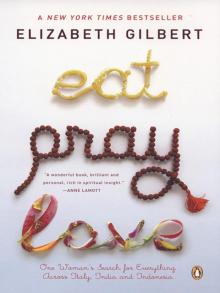 Eat, Pray, Love
Eat, Pray, Love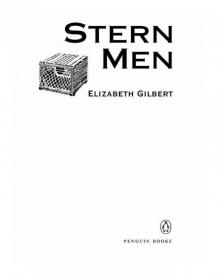 Stern Men
Stern Men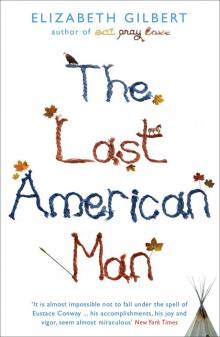 The Last American Man
The Last American Man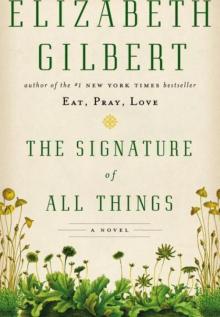 The Signature of All Things
The Signature of All Things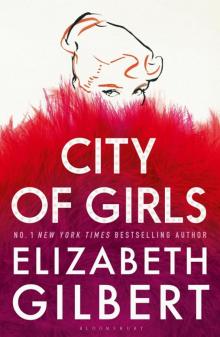 City of Girls
City of Girls Pilgrims
Pilgrims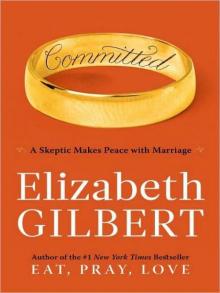 Committed: A Skeptic Makes Peace With Marriage
Committed: A Skeptic Makes Peace With Marriage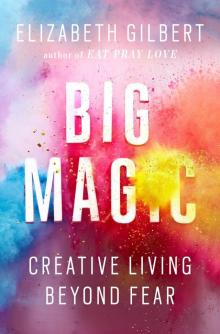 Big Magic
Big Magic Committed
Committed The Best American Travel Writing 2013
The Best American Travel Writing 2013